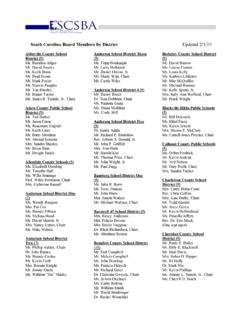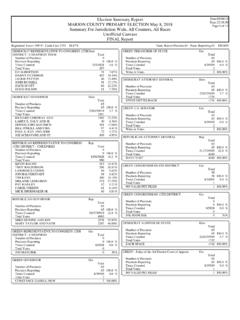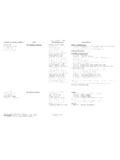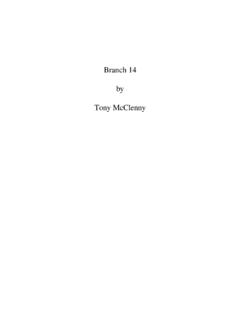Transcription of Abbeville County School District v. State of South …
1 8/20/20151 How Did We Get Here and What Happens Now? Abbeville County School District v. State of South CarolinaLaura Callaway HartDuff, White & Turner, LLCSCSBA School Law ConferenceAugust 20151SC Constitution s Education Clause:Article XI, Section 32 The General Assembly shall provide for the maintenance and support of a system of free public schools open to all children in the State ..8/20/20152 Education Finance Act (EFA)of 19773 Drafted in 1974 Defined Minimum Program Base Student Cost Assumed District size of 6000 students No transportation No fringe benefits No facilities Shared formula 70% State and 30% local (avg.) Index of Taxpaying AbilityEducation Improvement Act (EIA) of 1984 4 Statewide penny sales tax Innovations and improvements Periodic reviews8/20/20153 Why a lawsuit?5 State re-directed costs to districts Straw that broke the camel s back fringe benefits Complaint filed November, 199368/20/20154 Abbeville County School District , et al. v. State of South Carolina, et 40 School districts in 1993 36 districts at time of trial in 2003 33 districts in 2015 No District has dropped out Consolidation reduced District countAbbeville v.
2 State of South Carolina8 Equal protection claims Education clause of the SC Constitution8/20/20155 Abbeville v. State of South Carolina9 Trial court granted defendants motions to dismiss in 1996 Separation of powers Plaintiffs appealed (1stappeal)10 First Appeal8/20/20156 Abbeville I(1999)11 It is the duty of this Court to interpret and declare the meaning of the Constitution. Abbeville I(1999)12SC Constitution s Education Clause:The General Assembly shall provide for the maintenance and support of a system of free public schools open to all children in the State ..8/20/20157 Abbeville I(1999)13 Since the education clause did not specify the qualitative standard required, the Supreme Court held that it must be at least minimally adequate. Abbeville I(1999)14 We hold today that the South Carolina Constitution s education clause requires the General Assembly to provide the opportunity for each child to receive a minimally adequate education. 8/20/20158 Abbeville I (1999)15We define this minimally adequate education required by our Constitution to include providing students adequate and safe facilitiesin which they have the opportunity to acquire: the ability to read, write and speak the Englishlanguage, and knowledge of mathematicsand physical science; a fundamental knowledge of economic, social, and political systems, and a history of governmental processes; and academic and vocational skills.
3 The provisions of the Constitution shall be .. construed to be mandatory.. Since the education clause uses the term shall, it is mandatory. Bottom line: The General Assembly must provide adequate educational opportunities to each I (1999)168/20/2015917 TrialThe Plaintiffs18 Eight trial plaintiff districts Allendale Dillon 2 Florence 4 Hampton 2 Jasper Lee Marion 7 Orangeburg 38/20/201510 Trial19 Bench trial Judge Thomas W. Cooper, Jr. Clarendon County Manning July 28, 2003 December 200420 Plaintiffs Evidence and Arguments8/20/201511 The Plaintiffs: Mostly Minority21% 2 Florence 4 Hampton 2 JasperLeeMarion 7 Orangeburg 3 StatePlaintiffsAllendaleDillon 2 Florence 4 Hampton 2 JasperLeeMa r i o n 7 Orangeburg 3 The Plaintiffs: Mostly Low Income22 Free Reduced558690858885788789840102030405060 708090100 StatePlaintiffsAllendaleDillon 2 Florence 4 Hampton 2 JasperLeeMarion 7 Orange burg 3 StatePlaintiffsAllendaleDillon 2 Florence 4 Hampton 2 JasperLeeMarion 7 Orangeburg 38/20/20151223248/20/201513 Teacher Qualifications:Plaintiff and Non-Plaintiff DistrictsInduction Contract AverageAllendaleDillon 2 Florence 4 Hampton 2 JasperLeeMarion 7 Orangeburg 3 Teacher Qualifications:Plaintiff and Non-Plaintiff DistrictsSubstandard Certificates and Out-of-Field AverageAllendaleDillon 2 Florence 4 Hampton 2 JasperLeeMarion 7 Orangeburg 38/20/201514 Teacher Qualifications.
4 Plaintiff and Non-Plaintiff DistrictsThree Year Average Teacher Turnover AverageAllendaleDillon 2 Florence 4 Hampton 2 JasperLeeMarion 7 Orangeburg 3288/20/20151529308/20/20151631328/20/20 151733 Auditorium/classroom348/20/201518 Media Center for 365 students35 Cafeteria for 365 students368/20/201519 What Did the Test Results Show? Students Scoring Below BasicPlaintiffNon-Plaintiff38A8/20/20152 0 What Did the Test Results Show?39 Unsatisfactory and Below Average Schools, State vs. Plaintiff Districts, 200340 Unsatisfactory and Below Average District Schools Rated Unsatisfactory or Below Average,2001 to 200341 Schools neverrated BA or USchools U or BAat least once79% of schools in plaintiff districts rated Unsatisfactory or Below Average three years in a row87% of schools in plaintiff districts rated Unsatisfactory or Below Average at least once over three yearsPlaintiff District Schools Moving out of Unsatisfactory or Below Average Ratings from 2001 to 200342 Schools RatedU or BA in2001 and stillin moved from Unsatisfactory or Below Average to Average or above in 20038/20/201522 Percentage of 9thgraders who did not complete high School in four years43 Allendale60%Dillon 243% Florence 466%Hampton 254% Jasper61%Lee67%Marion 344%Marion 444% Orangeburg 3 Orangeburg 348%448/20/201523 Economic Base45 Textile and agriculture jobs disappearing Knowledge-based economy is our only choiceRoche Carolina s Hiring Efforts for 20 Job Openings 1.
5 474 Applications Received 1,200 High School Graduates 737 Signed Up for Testing 549 Showed Up for Testing 63 Passed Test468/20/20152447 Funding:Eroded, obsolete, and complex48 Base student cost, developed in 1974, excludes: Transportation Facilities Fringe benefits 4 additional Carnegie units Technology Other mandates8/20/201525 Funding:Eroded, obsolete, and complex49 EIA penny used for basics (not as designed) Teacher salary funding eroded Facility funding from Barnwell dried up Lottery money widely dispersed Tax reform, including Act 388 and exclusions508/20/2015265152 Defendants Evidenceand Arguments8/20/201527 Defendants Evidence and Arguments Court has no role in education Legislative prerogative State required to provide only the bare minimum Poverty causes low educational achievement53548/20/20152855 December 29, 200556 Trial Court Order8/20/201529 Trial Court Order 57 Pieces of the education system are minimally adequate: Facilities System for training and distributing teachers Te a c h e r c o m p e n s a t i o n Teacher turnover (problematic, but not a constitutional issue) Physical supports (materials, technology, books) Instructional time (summer School , after School )BUTT rial Court Order58 Have the Defendants provided the children in the Plaintiff Districts the opportunity to acquire a minimally adequate education?
6 I find they have Court Order59 Opportunity means a real chance, an education that will prepare children for Court Order60 Poor children can learn, and their outcomes cannot be excused because they are Court Order61 The impact of poverty must be addressed in order to ensure the opportunity for a minimally adequate education to poor Court Order62 The State is not ensuring that children in poverty have the opportunity to acquire a minimally adequate education because of the lack of early childhood interventions designed to address the impact of poverty8/20/20153263 Second AppealAppeal Issues64 Plaintiffs appealed conclusions on Facilities Teacher quality issues Funding Other educational supports Remedy: What about the older children?8/20/201533 Appeal Issues65 Defendants appealed the court's requirement that they do anything Separation of powers Legislative prerogative to decideDuring the Appeal66 General Assembly enacted CDEPP (Child Development Education Pilot Program) via proviso for 4-year old children in the plaintiff districts.
7 Note: Trial court did not limit early childhood interventions to 4-year olds. It referred specifically to birth to grade three. 8/20/201534 The November 12, 2014 Supreme Court Opinion67 Abbeville IIAbbeville II68 [I]nterpretation of the law and evaluation of the government s acts pursuant to that law are critical and necessary judicial functions. As such, we find that judicial intervention is both appropriate and necessary in this instance. 8/20/201535 Abbeville II69 We hold that South Carolina s educational funding scheme is a fractured formula denying students in the Plaintiff Districts the constitutionally required opportunity. Abbeville II70 There is a clear disconnect between spending and results8/20/201536 Abbeville II71 Poverty the critical issue [A] focus on poverty within the Plaintiff Districts likely would yield higher dividends than a focus on perhaps any other variable. Abbeville II72 Other issues also cause negative impacts: Teacher quality - a corps of unprepared teachers Inadequate transportation Adverse impact of local legislation Small District size8/20/201537 Abbeville II73 [O]ur State s education system fails to provide School districts with the resources necessary to meet the minimally-adequate standard.
8 Abbeville II74 [T]he cost of the educational package in South Carolina is based on a convergence of outmoded and outdated policy considerations that fail the students of the Plaintiff Districts. 8/20/201538 Abbeville II75 The Remedy Separation of powers issue General Assembly is primarily responsible for schools and is proper institution to make policy choicesAbbeville II76 Charge to the Defendants: Take a broad look at principal causes of low student achievement Consider the wisdom of continuing to enact multiple statutes which have no demonstrated effect on educational problems, or attempting to address deficiencies through underfunded and structurally impaired programming. 8/20/201539 Abbeville II77 Charge to the Plaintiff Districts: Work with the Defendants to chart path forward that prioritizes student learning Consider consolidationAbbeville II78 Court retained jurisdiction. Parties invited to suggest a timeline for reappearance and specific, planned remedial measures8/20/201540792015: The RemedyNot this way:808/20/201541 Plaintiffs Strategy Group81 Education experts Package of systemic reformsPlaintiffs Framework for Abbeville Remedy82 Support local capacity for long term successImprove the quality, stability, and effectiveness of the teaching force and leadership teamProvide high quality early childhood education, birth through grade 3 Provide students in grades 4-8 high qualitylearning opportunities and experiencesProvide students in grades 9-12 high quality learning opportunities and experiencesProvide for accountability through monitoring the quality of implementation for continuous improvement8/20/201542SC House Education Policy Review and Reform Task Force83 Rep.
9 Rita Allison Chair House members Business representatives Representatives of Plaintiff DistrictsSC House Education Policy Review and Reform Task Force84 Plaintiffs recommendations Dr. JoAnne Anderson s testimony on June 1, 20158/20/201543SC Senate Finance Special Subcommittee for Response to AbbevilleCase85 Sen. Nikki Setzler (Co-Chair) Sen. Wes Hayes (Co-Chair) Sen. John Courson Sen. John Matthews Sen. Greg HembreeWhen???????86 Plaintiffs filed motion with Supreme Court June 18, 2015 Framework for legislative reform Timeline: by end of 2016 legislative session Defendants oppose motion8/20/20154488 Some Truths8/20/201545 Brown v. Board of Education Today, education is perhaps the most important function ofstate and local governments.. It is required in theperformance of our most basic public responsibilities, evenservice in the armed forces. It is the very foundation of goodcitizenship. Today, it is a principle instrument in awakening thechild to cultural values, in preparing him for later professionaltraining and helping him to adjust normally to his these days, it is doubtful that any child may reasonably beexpected to succeed in life if he is denied the opportunity of aneducation.
10 Thomas Jefferson (1786), on education and democracy90 No other sure foundation can be devised for the preservation of freedom and happiness.. The tax which will be paid for this purpose is not more than the thousandth part of what will be paid to kings, priests and nobles who will rise up among us if we leave the people in ignorance. 8/20/201546 Thomas Jefferson (1816)91 If a nation expects to be ignorant and free, in a State of civilization, it expects what never was and never will be. 92





